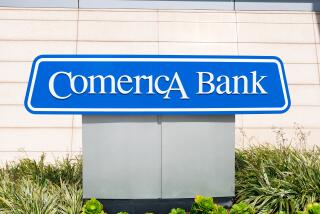Small Banks Took on More Risk in 1995, FDIC Finds
- Share via
WASHINGTON — Small banks didn’t ease their lending standards last year but about 11% took on more risk than usual, particularly in commercial real estate loans, the Federal Deposit Insurance Corp. said Monday.
The survey of loan underwriting practices is intended to give the FDIC an early warning of loan problems.
“While in general the reports were positive, we did see a pickup of above-average risk in some states at levels that warrant attention,” said James L. Freund, an FDIC economist who prepared the report.
Freund said that in many of the 2,001 banks, two-thirds of which were small community institutions, “no widespread loosening of underwriting standards was detected.”
The larger banks in the FDIC review, those with more than $300 million in assets, had fewer cases of a growing appetite for risky loans, the agency said.
The FDIC said its examiners may find one or two weaknesses, but they would be offset by strengths in other areas.
The survey found that speculative construction lending was a concern at almost 14% of institutions, while consumer lending practices were a problem at about 10% of banks.
One problem in nearly half of the institutions was a failure to increase loan interest rates to reflect greater risks, such as a slower economy. In 45% of the cases, examiners said banks didn’t do a good enough job in verifying alternative repayment sources for loans.
Robert W. Walsh of the FDIC said the agency intends to watch closely the flaws in commercial real estate and construction lending, particularly in California. Other examiners said they were watching for potential problems in agricultural loans because of Congress’ recent decision to eliminate agricultural subsidies.
For example, FDIC examiners found loan portfolios with above-average risk in 38% of California banks surveyed, in 25% of Louisiana banks and in 24% of New York banks.
Banks generally take on more risk when the economy is expanding, particularly after a long recession when banks clamp down on lending and create pent-up demand for business loans.
More to Read
Inside the business of entertainment
The Wide Shot brings you news, analysis and insights on everything from streaming wars to production — and what it all means for the future.
You may occasionally receive promotional content from the Los Angeles Times.










